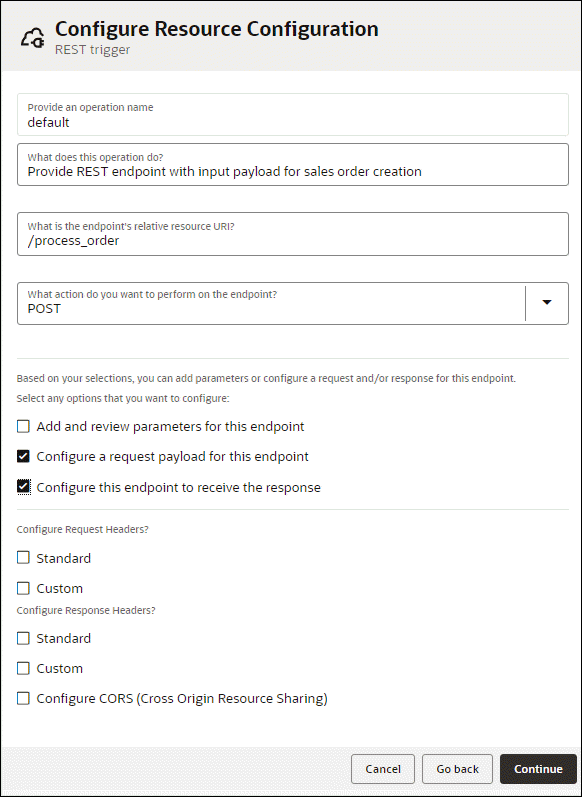Add the REST Adapter as a Trigger (Source) Connection
You need to add a trigger (source) connection in the integration. The trigger (source) connection can be any application adapters suitable for your integrations. In this example, the REST Adapter is used for the integration.
Perform the following steps to add the REST Adapter as a trigger (source) connection:
-
In the Create Order integration canvas, click the + sign in the integration canvas or click Triggers
 on the side of the canvas. A list of trigger connections appears.
on the side of the canvas. A list of trigger connections appears.
-
Search and select the "GenericREST" connection that you created earlier from the list of trigger connections. The REST Adapter Endpoint Wizard appears.
-
Enter the following information in the Configure Basic Info page:
-
What do you want to call your endpoint? - Enter the name of this endpoint, such as "Source".
-
What does this endpoint do? - Enter the usage of this endpoint, such as "Provide REST endpoint with input payload for sales order creation".
-
Select to configure multiple resources or verbs (maximum 11)? - Leave this field unchecked.
Click Continue.
-
- In the Configure Resource Configuration page, enter the following information:
-
What does this operation do? - Enter the usage of this operation, such as "Provide REST endpoint with input payload for sales order creation".
-
What is the endpoint's relative resource URI? - Enter "
/process_order". -
What action do you want to perform on the endpoint? - Select "POST" from the drop-down list.
-
Configure a request payload for this endpoint - Select this checkbox indicating that a request payload is required in this activity.
Ensure that you select the following two checkboxes for this trigger (source) connection:
-
Configure a request payload for this endpoint
-
Configure this endpoint to receive the response
Click Continue. -
-
In the Configure Request page, perform the following tasks:
-
In the "Select the request payload format" field, select JSON Sample.
Please note that the request payload file type can be either XML schema or JSON format.
-
In the Sample Location field, click + to select a desired request payload, such as "request.json". Click Open to attach the selected file.
For the sample request payload, see Sample JSON Payloads for the Oracle E-Business Suite Adapter as an Invoke Example for a PL/SQL REST Service.
-
In the "What is the media-type as Request Body? (Content-Type Header)" section, select the JSON button as the type.
Click Continue.
-
-
In the Configure Response page, select JSON Sample as the response payload format for this example.
Similar to the request, the response payload type can be either XML schema or JSON format.
In the Sample Locaton field, click + to select a desired request payload file, such as "response.json". Click Open to attach the selected file.
For the sample response payload, see Sample JSON Payloads for the Oracle E-Business Suite Adapter as an Invoke Example for a PL/SQL REST Service.
In the "What is the media-type as Response Body? (Accept Header)" section, select the JSON button as the type.
-
Click Continue.
This displays the Summary page with the following REST service information that you specified earlier. Click Finish.
Click Save to save your work. The GenericREST connection now appears in the canvas.


